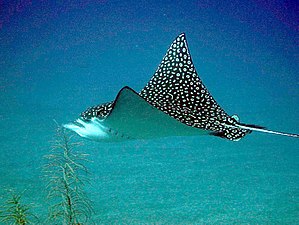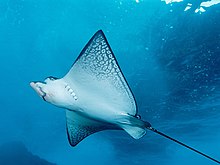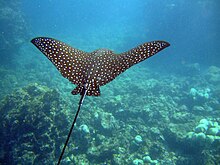Spotted eagle ray
| Spotted eagle ray | ||||||||||||
|---|---|---|---|---|---|---|---|---|---|---|---|---|

Spotted eagle ray ( Aetobatus narinari ) |
||||||||||||
| Systematics | ||||||||||||
|
||||||||||||
| Scientific name | ||||||||||||
| Aetobatus narinari | ||||||||||||
| ( Euphrasén , 1790) |
The spotted eagle ray ( Aetobatus narinari ) is a species of ray that is found in all tropical and almost all subtropical seas. In the Atlantic, the distribution area extends in the west of North Carolina (only in summer) and Florida over the Bermuda , the Caribbean and the Gulf of Mexico to the coast of southern Brazil . In the eastern Atlantic it stretches from Mauritania to Angola . It also inhabits the Red Sea and the Indo-Pacific from the east coast of Africa, north to Japan , south to Australia and east to the Gulf of California and the Galapagos Islands . The populations in the distant areas are not particularly genetically similar and the species may have to be split into several species.
features
The spotted eagle ray with its long, whip-like tail reaches a maximum length of 3.30 meters, but usually stays at a length of 1.80 meters. The head, torso and pectoral fins create a diamond-like body profile. The snout protrudes and has a slightly duckbill-like appearance due to the concave top. The upper and lower jaws are covered with a row of flat teeth. The spotted eagle rays are blackish or bluish on top and patterned with many small, whitish dots that appear light blue under water because of the absorption of the red light component. The ventral side is white. There are no spines on the back. On its first third, just behind the small dorsal fin, the tail has one to five long, barbed spines. A caudal fin is missing. While the primitive guitar fish , as well as the sawfish and the jitter Roche-like move around like most sharks by strain snaking of the body and the tail fin and the genuine rays get around by undulating movements of their large pectoral fins, spotted beat eagle rays as all the other eagle rays like birds with their wings with the enlarged pectoral fins.
Way of life
The spotted eagle ray lives mainly in shallow coastal waters such as bays and coral reefs , either close to the water surface or close to the ground, at depths of one to 60 meters. However, it can also cross the open ocean. The animals sometimes jump out of the water. Outside the mating season, they often form large schools of up to 200 individuals. The spotted eagle ray feeds mainly on mussels . It also eats shrimp , crayfish, squid and worms. Larger specimens mainly eat fish. Like all eagle rays, it is ovoviviparous . After a gestation period of twelve months, only one to four young rays are born per litter, and they already have a wingspan of half a meter at birth.
literature
- Hans A. Baensch / Robert A. Patzner: Mergus Sea Water Atlas Volume 6 Non-Perciformes (Non-Perciformes) , Mergus-Verlag, Melle, 1998, ISBN 3-88244-116-X
Web links
- Spotted eagle ray on Fishbase.org (English)
- Aetobatus narinari inthe IUCN 2013 Red List of Threatened Species . Posted by: Kyne, PM, Ishihara, H, Dudley, SFJ & White, WT, 2006. Retrieved November 3, 2013.


